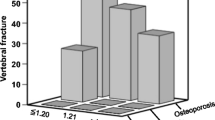Abstract
The prevalence of osteoporosis in older patients with chronic obstructive pulmonary disease (COPD) is higher than in the age-matched elderly patients, but the exact cause in relation to COPD is not clear. We hypothesized that the underlying causes for this difference are related to bone metabolism with the possible risk factors that include the duration of COPD, GOLD grade, cor pulmonale, the frequencies of acute exacerbations within the past year, smoking and inhaled corticosteroid therapy. We conducted a matched-pair study of 100 patients aged older than 65 years at the Southwest Hospital from May to November 2012. The enrolled patients with COPD were matched to controls for age and gender. Clinical characteristics of cohorts were recorded. Bone mineral density (BMD) was measured using dual-energy X-ray absorptiometry and osteoporosis was diagnosed according to the definition of WHO. All cohorts accepted bone metabolism marker measurement, including Procollagen type 1 aminoterminal propeptide (P1NP), β-C-telopeptides of type I collagen (βCTX), and N-terminal midmolecule fragment osteocalcin (N-MID OC). Statistical analysis was calculated using the student’s t test, ANOVA and multiple regression analysis at a significance level set at a p < 0.05. Circulating biochemical markers of bone formation (P1NP), resorption (βCTX) and turnover (N-MID OC) were significantly lower in the COPD group than control group, while mean 25-OH Vitamin D was similar in two groups. The P1NP, βCTX, and N-MID OC were still lower in men with COPD, but only P1NP was lower in women with COPD compared to that of controls. Multiple regression analysis in COPD group suggests that age, the frequency of acute exacerbation, and BMD are independent risk factors for P1NP. The frequency of acute exacerbation within the past one year and 25-OH D level are independent risk factors for βCTX; the frequency of acute exacerbation is the only independent risk factor for N-MID OC. These were significant differences in bone metabolism in patients with or without COPD. These results should help us to further understand the cause of osteoporosis and fractures and conduce to prevent osteoporosis in patients with COPD.
Similar content being viewed by others
References
Graat-Verboom, L., Smeenk, F. W., van den Borne, B. E., Spruit, M. A., Jansen, F. H., van Enschot, J. W., et al. (2012). Progression of osteoporosis in patients with COPD: A 3-year follow up study. Respiratory Medicine, 106, 861–870.
Kjensli, A., Falch, J. A., Ryg, M., Blenk, T., Armbrecht, G., Diep, L. M., et al. (2009). High prevalence of vertebral deformities in COPD patients: Relationship to disease severity. The European Respiratory Journal, 33, 1018–1024.
Rittayamai, N., Chuaychoo, B., & Sriwijitkamol, A. (2012). Prevalence of osteoporosis and osteopenia in Thai COPD patients. Journal of the Medical Association of Thailand, 95, 1021–1027.
Singh, S., & Loke, Y. K. (2010). An overview of the benefits and drawbacks of inhaled corticosteroids in chronic obstructive pulmonary disease. International Journal of Chronic Obstructive Pulmonary Disease, 5, 189–195.
Friis-Holmberg, T., Brixen, K., Rubin, K.H., Grønbæk, M., & Bech, M. (2012) Phalangeal bone mineral density predicts incident fractures: A prospective cohort study on men and women-results from the Danish Health Examination Survey 2007–2008 (DANHES 2007–2008). Archives of Osteoporosis, 7(1–2), 291–299.
Lillholm, M., Ghosh, A., Pettersen, P. C., de Bruijne, M., Dam, E. B., Karsdal, M. A., et al. (2011). Vertebral fracture risk (VFR) score for fracture prediction in postmenopausal women. Osteoporosis International, 22, 2119–2128.
Ogura-Tomomatsu, H., Asano, K., Tomomatsu, K., Miyata, J., Ohmori, N., Kodama, M., et al. (2012). Predictors of osteoporosis and vertebral fractures in patients presenting with moderate-to-severe chronic obstructive lung disease. COPD, 9, 332–337.
Duckers, J. M., Evans, B. A., Fraser, W. D., Stone, M. D., Bolton, C. E., & Shale, D. J. (2011). Low bone mineral density in men with chronic obstructive pulmonary disease. Respiratory Research, 12, 101.
Higgins, D. M., Wischmeyer, P. E., Queensland, K. M., Sillau, S. H., Sufit, A. J., & Heyland, D. K. (2012). Relationship of vitamin D deficiency to clinical outcomes in critically ill patients. JPEN Journal of Parenteral and Enteral Nutrition, 36, 713–720.
Tiwari, S., Pratyush, D. D., Gupta, B., Dwivedi, A., Chaudhary, S., Rayicherla, R. K., et al. (2013). Prevalence and severity of vitamin D deficiency in patients with diabetic foot infection. British Journal of Nutrition, 109, 99–102.
Liang, B., & Feng, Y. (2012). The association of low bone mineral density with systemic inflammation in clinically stable COPD. Endocrine, 42, 190–195.
Bai, P., Sun, Y., Jin, J., Hou, J., Li, R., Zhang, Q., et al. (2011). Disturbance of the OPG/RANK/RANKL pathway and systemic inflammation in COPD patients with emphysema and osteoporosis. Respiratory Research, 12, 157.
Olmos, J. M., Hernández, J. L., Llorca, J., Nan, D., Valero, C., & González-Macías, J. (2012). Effects of 25-hydroxyvitamin D3 therapy on bone turnover markers and PTH levels in postmenopausal osteoporotic women treated with alendronate. The Journal of Clinical Endocrinology and Metabolism, 97, 4491–4497.
Kruger, M. C., Ha, P. C., Todd, J. M., Kuhn-Sherlock, B., Schollum, L. M., Ma, J., et al. (2012). High-calcium, vitamin D fortified milk is effective in improving bone turnover markers and vitamin D status in healthy postmenopausal Chinese women. European Journal of Clinical Nutrition, 66, 856–861.
Acknowledgments
This work was supported by a grant from the Chongqing Science and Technology Foundation (No. cstc2012gg-yyjs0730).
Conflict of interest
The authors declare that they have no conflict of interest.
Author information
Authors and Affiliations
Corresponding author
Rights and permissions
About this article
Cite this article
Xiaomei, W., Hang, X., Lingling, L. et al. Bone Metabolism Status and Associated Risk Factors in Elderly Patients with Chronic Obstructive Pulmonary Disease (COPD). Cell Biochem Biophys 70, 129–134 (2014). https://doi.org/10.1007/s12013-014-9868-9
Published:
Issue Date:
DOI: https://doi.org/10.1007/s12013-014-9868-9



